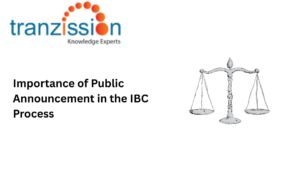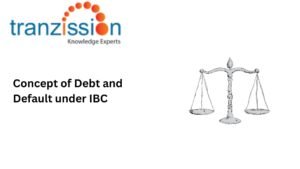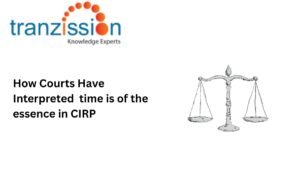
Section 7 of IBC – Insolvency and Bankruptcy Code
Table of Contents
The Insolvency and Bankruptcy Code, 2016 (IBC) was enacted to consolidate and amend the laws relating to reorganisation and insolvency resolution process of corporate persons, partnership firms, and individuals in a time-bound manner. To initiate the insolvency process under the Section 7 of IBC , the applicants should clearly understand their debt, to be defined as a “financial creditor” or “operational creditor”. This depends on the relationship with the corporate debtor, meaning the nature of work and the type of debt they are owed from the corporate debtor. A financial creditor can make an application for initiating the insolvency process under a section of the IBC.
Understanding Section 7 of the Insolvency and Bankruptcy Code
A creditor can trigger the process to recover their dues if a company fails to pay them according to the terms of an agreement. To understand this in more detail, let’s look more into section 7:
Key Provisions Under Section 7 of IBC:
Under section 7 of IBC, the financial creditor, either by itself or with other financial creditors may file an application for initiating a corporate insolvency resolution process (CIRP) against the corporate debtor before the National Company Law Tribunal (NCLT) when a default occurs. Financial creditors include any person to whom a financial debt is owed and consists of those to whom such debt has been legally assigned or transferred to, for instance banks and financial institutions.
Threshold for Filing:
Section 4(1) states that the minimum amount of default is Rs. 1 lakh. The Central Government may, by notification, specify the minimum amount of default of higher value which shall not be more than Rs. 1 crore.
Timeline for CIRP Initiation:
The timeframe of initiation of the insolvency process is given under section 7(4) of the IBC. The NCLT shall within 14 days of the receipt of the application, ascertain the existence of a default from the records of an information utility or based on other evidence furnished by the financial creditor. If the NLCT must admit or reject an application within the 14-day timeline.
Procedure for Initiating CIRP Under Section 7 of IBC
The process for initiating CIRP under this section is simple and can be done in three simple steps:
Filing an Application:
Section 7 of IBC read along with Rule 4 of the Insolvency and Bankruptcy (Application to Adjudicating Authority) Rules, 2016 (hereon forward known as “the Rules”), states that a financial creditor shall make an application for initiating the CIRP in Form 1, accompanies with documents and records of default, financial agreements, and evidence of default and filing fee applicable for financial creditors, the name of the resolution professional (RP) proposed to act as an interim resolution professional (IRP), and any other information that may be specified by the Insolvency and Bankruptcy Board of India (IBBI).
Role of the NCLT:
The NCLT evaluates the application within 14 days of its reciept and will admit the application if it is satisfied that a default has occurred, the application is complete, and no disciplinary proceedings are pending against the proposed RP. The application will be rejected if the default has not occurred, the application is incomplete, or there are any disciplinary proceedings pending against the proposed RP. Hence, the NCLT at this stage has the responsibility of ensuring the application meets all procedural requirements.
Appointment of an Interim Resolution Professional:
The NCLT appoints the IRP on the insolvency commencement date, according to section 16 of the IBC. From the date of appointment, the IRP has to manage the affairs of the corporate debtor and continues to do so till the date of appointment of the RP.
Key Features of Section 7 Proceedings
Upon reading section 7 of IBC, the main features include:
Creditor-Driven Process:
Section 7 of IBC is a “creditor-driven process”, meaning that financial creditors initiate the CIRP against a corporate debtor when a default occurs, giving the power to start the insolvency proceedings in the hands of the creditors.
No Requirement for Negotiations Before Filing:
According to the process for initiating the resolution process under Section 7 of IBC, financial creditors do not need to engage in pre-litigation negotiations before filing an application
Focus on Debt Recovery and Resolution:
This section prioritizes resolution over liquidation by encouraging the submission of resolution plans for the revival of the debtor. Financial creditors submit their proposals to restructure the company’s debts and potentially save it as a going concern.
Challenges and Criticisms of Section 7
Delays in Admission of Applications:
Despite the strict 14-day timeline for the NCLT to admit or reject the Section 7 of IBC application, there are still delays in this decision.
Misuse by Financial Creditors:
Some judicial observations have noted that financial creditors have misused Section 7 of IBCto pressure corporate debtors.
Impact on Micro, Small, and Medium Enterprises:
Section 7 of IBC applications can disproportionately impact MSMEs that may not have the resources to withstand insolvency proceedings. This severely disrupts the observations of such companies and may lead to their direct liquidation rather than revival. Hence, the IBBI introduced the pre-packaged insolvency resolution process (PPIRP) for MSMEs through the Amendment Act, 2021.
Judicial Interpretations of Section 7
The Hon’ble Supreme Court in Swiss Ribbons v. Union of India upheld the constitutionality of section 7, confirming the distinction between financial creditors and operational creditors under the IBC and validating the different treatment afforded to each category. The ruling in Innoventive Industries Ltd. v. ICICI Bank clarified that a default under section 7 can be for any financial debt owed to a corporate debtor, not just the applicant’s financial creditor. This landmark case clarified the criteria for NCLT to admit applications under Section 7, focusing on debt and default verification. The rights of financial creditors were strengthened in insolvency proceedings under section 7 in the Essar Steel Case.
Comparison with Sections 8 and 9 of IBC
| Aspect | Section 7 | Section 9 | Section 10 |
| Who can file | Financial Creditor | Operational Creditor | Corporate Debtor |
| Relates to | Financial Debt | Operational Claims | Defaults made by the corporate debtor itself |
| Process | Filed directly with the NCLT | The operational creditor has to send a demand notice to the company regarding the outstanding debt | The company needs to pass a resolution to apply with the NCLT acknowledging its insolvency. |
Recommendations to Improve Section 7 Framework
Although Section 7 provides clear details and strict timelines, there are certain practical challenges, therefore it is recommended to:
Strengthen NCLT Infrastructure:
The NCLT is overburdened with cases, leading to a delay in the overall resolution process. Therefore, it is recommended to increase the capacity of NCLTs to ensure timely disposal of Section 7 applications.
Prevent Misuse by Financial Creditors:
The misuse of the insolvency provisions is a major issue. To address this promptly, the IBBI can establish provisions for stricter scrutiny of applications, avoiding frivolous filings and misuse of Section 7 provisions.
Expand the Awareness Among Creditors:
The IBBI should take the initiative to educate financial creditors, especially smaller lenders, on effectively utilizing Section 7 provisions.
Read more :Role of ESG in Corporate Governance
The Future of Section 7 in India’s Insolvency Framework
Section 7 of the IBC is likely to see a focus on improving efficiency in initiating insolvency proceedings against corporate debtors by financial creditors. This may involve establishing amendments to address the delays in the later stages of the process while maintaining a balance between creditor rights and debtor protection through judicial interpretation and possible refinements to the default criteria.
Conclusion
Section 7 of the IBC empowers financial creditors by allowing them to initiate a CIRP against a corporate debtor when a default occurs, essentially giving them the legal authority to start insolvency proceedings against a company if it fails to meet its financial obligations to them, this strengthens their position to recover outstanding debts. The NCLT is required to verify the default and admit the application if it is complete and no disciplinary actions are pending against the proposed resolution professional. However, there are certain challenges in submitting the Section 7 application, such as interpreting default or claims that the debt is not yet due and the financial creditor must have a proper board resolution explicitly authorizing the initiation of CIRP.





